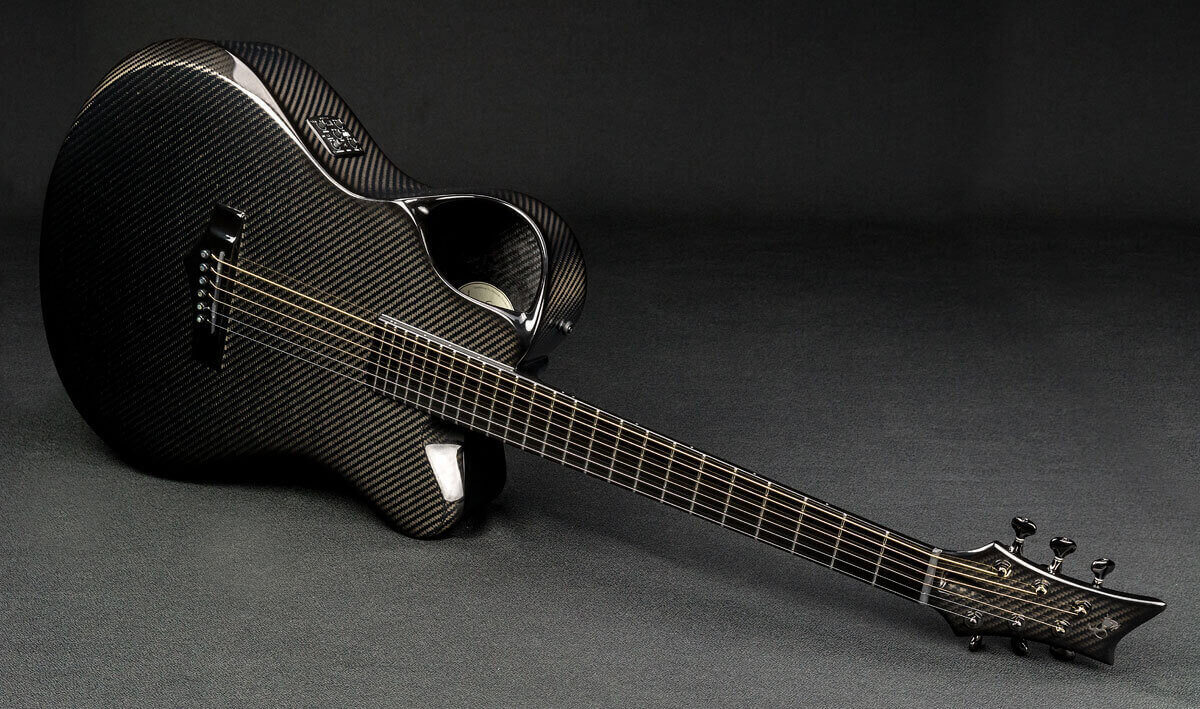Carbon fiber guitars are fairly new in the guitar industry, but they certainly have a lot of features that make them very appealing to guitarists.
These features include things such as low weight, high chemical resistance, high-temperature resistance, and low thermal expansion.
In my opinion, carbon fiber guitars are not going to replace wood body guitars anytime soon, but eventually, they could get very close to doing so.
In this article, I will be talking about what exactly carbon fiber is, how carbon fiber guitars are made, their advantages and disadvantages, and a brief history of how this concept developed throughout the years.
Here are 10 interesting facts about carbon fiber guitars that you must know:
Table of Contents
- 1- Carbon fiber guitars are extremely lightweight
- 2- They are impervious to intense temperature and humidity changes
- 3- Carbon fiber acoustic guitars are louder than wood acoustic guitars
- 4- Composite materials are very strong and powerful
- 5- These guitars are also water-resistant
- 6- Carbon fiber is available in many different patterns
- 7- The earliest recorded application of carbon fiber was in 1860
- 8- Manufacturing carbon fiber guitars is immensely complicated and costly
- 9- The price of a carbon fiber guitar can usually be up to approximately $3,199
- 10- The sound you hear in a carbon fiber guitar will be its sound forever
- Are carbon-fiber guitars good for traveling?
- Carbon Fiber vs Wood
1- Carbon fiber guitars are extremely lightweight
You will hear a lot of people saying that carbon fiber guitars are even lighter than most laptops! And this is very true in most cases.
Now, being lightweight doesn’t mean that they can easily break, in fact, that’s one of the many reasons why carbon fiber is being used to build guitars.
Carbon fiber is a material that’s very known to have a very high strength-to-weight ratio.
The strength-to-weight ratio of a given material is really just the strength of the material divided by its mass.
Being lightweight makes it easier for musicians to transport it since it’s much less likely to be damaged during shipping
Let’s take a look at this KLOS Black Carbon Fiber Full Size Acoustic Guitar:
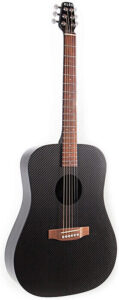
This guitar is only 3.85 pounds!
If we compare it to a Martin D-28 Dreadnought Acoustic Guitar, for example, the Martin guitar would be around 4.8 pounds.
Now, I know, even I think 1 pound more or less won’t make a huge difference.
As a matter of fact, there’s a lot of debate around this topic with guitarists having different opinions on whether weight affects the overall guitar tone or not.
For the most part, the big majority believes that when it comes to tone, a guitar’s weight is nowhere near as important as the amp, the strings, the guitar body shape, and even the talent of the guitar player.
On the other hand, some guitarists think that a heavier instrument will sound better because it gives you better sustain and a thicker and fuller tone.
This reasoning is backed by the idea that heavier acoustic guitars tend to have bigger sizes, and if that’s the case, then of course that’s definitely a good argument; guitar sizes do affect the sound of the instrument.
2- They are impervious to intense temperature and humidity changes
Carbon fiber guitars are impervious to intense temperature and humidity changes.
But, what does that even mean?
According to vocabulary.com:
An impervious surface is one that can’t be penetrated.
In other words, these guitars are physically or chemically unaffected by high/low temperatures.
To put it into perspective, normal wood guitars, if left in constantly changing environments and temperature, can expand or contract, resulting in string buzzing, tuning and intonation problems, cracks, and changes in the guitar tone.
With carbon fiber guitars, though, it doesn’t matter if you leave it outside in summer weather, or leave it the next day in winter weather, the guitar would be unbothered by the temperature and humidity changes.
This means that the guitar sound and tone will remain the same on both occasions and the body of the guitar will stay in identical conditions.
For example, the LAVA ME 2 Carbon Fiber Guitar it’s believed to be capable of adapting to temperatures between -4°F~176°F and humidity levels from 10% to 90%.
Note: That seems to be approximately the same for almost all carbon fiber guitars, though there could be a few exceptions.
Now, a word of caution, this doesn’t mean that if you buy or have a carbon fiber guitar, that you should go ahead and ignore basic guitar care and maintenance needs.
You still need to take reasonable care of any instrument, even if it’s made out of carbon fiber.
Another advantage of being impervious to temperature and humidity changes is that when traveling, guitarists won’t have to worry about their guitars breaking or having to use different instruments for different occasions (in case of touring, for example).
3- Carbon fiber acoustic guitars are louder than wood acoustic guitars
This seems to be among the many selling propositions of multiple carbon fiber guitar brands.
KLOS guitars, for example, describes one of their full-size acoustic guitars as having “a sound people describe as very rich, loud, and resonant with a nice balanced tone.”
After doing a little bit of research online, it seems that not a lot of people actually know why these guitars are in fact louder.
Whenever someone plays a carbon guitar for the first time, this is one of the first comments that they are naturally inclined to give.
There’s a lot of debate on this topic and people are always having very inconsistent opinions.
Some people believe that these guitars are not necessarily “louder” to any significant degree, but rather just more “clear” sounding since certain overtones are more prominent.
And this is true, carbon fiber guitars are generally brighter, with a longer sustain, and at the same time, more responsive, which puts the peak of the sound very early in the pluck.
By peaking faster, having more sustain, and a broader range of overtones this essentially gives the guitarist the illusion of more volume.
Now, remember, all carbons are not the same.
Some of these guitars sound better than others, and some are known for having more crystalline treble tones.
4- Composite materials are very strong and powerful
Carbon fiber is an infusion of the most durable fibers and the strongest resin.
These guitars are definitely stronger than your average instrument.
In order to actually break a carbon fiber guitar, you would really have to put a lot of effort into doing so.
Take a look at this next YouTube video. Even though they’re using a Ukelele to prove their point, it still shows how strong and powerful composite materials are:
The first test that they did consisted of a 3,000 pounds Prius completely driving over a Carbon fiber Ukulele.
This is very impressive, to say the least!
But why does having a strong and powerful guitar matter?
Well, strong guitars are ideal as traveling instruments and they definitely make it easy for musicians to move around from show to show without having to care much about breaking their guitar.
Having a strong guitar that’s also impervious to intense temperature and humidity changes definitely completes the dream full package that any guitarist wishes to have.
If you have had any guitar for more than two years and have played it at least daily, chances are, you have caused some damages to the finish of the instrument.
This is also another reason why using carbon can be useful, they help to preserve the original conditions and state of your guitar when you first bought it.
5- These guitars are also water-resistant
Unlike wood-guitar, carbon fiber guitars are able to be submerged in water without being excessively damaged.
Now, for some people, this might not be such an important feature to have in a guitar.
If you think about it, unless you play guitar on a boat, or close to water, then you won’t really need to be careful about your guitar being submerged in water.
Most of the time, though, guitars get damaged not by “being dropped in the ocean” or anything extreme, but just by simple accidents such as spilling a drink into your instrument or leaving it out in the rain.
Those scenarios are where the real-life use of being water-resistant can be exceptionally helpful.
In other words, acoustic guitars made of wood will not simply get damaged by just a little bit of water.
It’s when we leave it exposed to excessive amounts of water that the glue bonds can break, and the neck angle improperly changes.
Guitars that get extremely wet can sound lifeless and dull from the extra water weight that the wood could be holding.
6- Carbon fiber is available in many different patterns
The old days of having simple natural wood patterns are not over yet, but they could be in the near future.
Using carbon fiber to make guitars allow manufacturers to have different shapes and colors that you would not otherwise have on a traditional wood instrument.
You might have seen some carbon fiber guitars that look something like this:
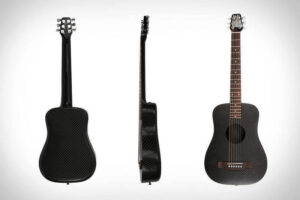
This pattern is one of the most common ones among all carbon fiber guitars out there nowadays.
All-black and with a specific pattern and texture on the guitar body!
Other guitar brands have also made it possible to have much more freedom in the design and shape of their guitars by using and advancing their very own carbon fiber molding technologies.
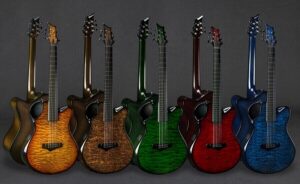
They are able to then achieve more interesting and unique models that can also be customized by our own choice of color, finish, hardware, and more.
Features like this one are especially useful and practical with the increasing trend and use of carbon fiber consumer products and the selling of more customized guitars.
7- The earliest recorded application of carbon fiber was in 1860
Even though the rising popularity of carbon fiber guitars has just recently begun to grow exponentially, many people are not aware of the fact that carbon fiber is not really a new technology.
The earliest recorded application of carbon fiber was in 1860, and guess what?
It was being used in light bulbs! This was attempted by Joseph Swan in the 1860s and then Thomas Edison in 1879.
According to Wikipedia:
Joseph Swan produced carbon fibers for the first time in 1860 for use in light bulbs.
However, the fact that these light bulbs lacked a good vacuum and an adequate electric source resulted in inefficient light and a short lifetime.

Joseph Swan | Source: Wikimedia Commons
It wasn’t until 1879, that Thomas Edison baked cotton threads or bamboo silvers at really high temperatures, carbonizing them into an all-carbon-fiber filament that was used in one of the first incandescent light bulbs to be heated by electricity.
Fast forward a few years, the high potential strength of carbon fiber was realized in 1963 in a process developed by W. Watt, L. N. Phillips, and W. Johnson at the Royal Aircraft Establishment at Farnborough, Hampshire.
The bottom line is that using carbon fiber for making musical instruments is a relatively new phenomenon.
8- Manufacturing carbon fiber guitars is immensely complicated and costly
In order to properly build a carbon fiber guitar, many different processes have to take place; these processes make the manufacturing of those same guitars complicated and costly.
Of course, it all varies depending on the brand that’s being discussed.
Generally, all these guitars are in the high-end price range since manufacturers must account for all the necessary labor, tools, and products to build the instruments and still run a profitable business.
Take a look at this YouTube video by Burls Art in which he builds an acoustic guitar out of carbon fiber cloth by himself.
This video alone goes to show how many different steps/stages building one guitar takes.
Even though at a large-scale, most companies make use of various techniques to build their own guitars, carbon fiber guitars always require extra caution and a more hands-on approach.
See how McPherson Carbon Series guitars are made by watching their factory tour video on YouTube.
By watching this last video, in contrast to the one before, you might be able to understand that even though bigger companies make use of automation and machines to help build their guitars, there’s still a fair amount of human interaction and supervision that needs to take place.
Having to work on every single detail of the guitar in the most perfect way possible requires a lot of attention, effort, and experience.
After all that evident work that we saw, it becomes easy to understand that it only makes sense for a company to increase its prices and include their costs of production within those prices.
This brings us to our next point…
9- The price of a carbon fiber guitar can usually be up to approximately $3,199
By doing a simple Google search with the keyword “carbon fiber guitars”, you will get presented with multiple options that will allow you to compare their prices side by side.
It should not be a surprise after we mentioned how manufacturing carbon fiber guitars is immensely complicated and costly, that some of their prices are extremely high.
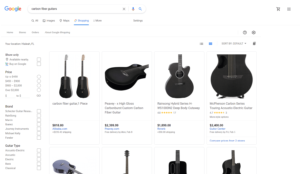
For the average person that’s just trying to learn to play guitar, some of those numbers can be very daunting.
On the other hand, I don’t even think that their target audience is beginner guitarists.
I would say they all market their brands more toward advanced guitar players that already know how to play and are willing to pay more money for a new instrument.
If you recently started out learning to play the guitar and are thinking about buying a carbon fiber guitar, in my opinion, you’re definitely going to get a great instrument, but just make sure that you find a guitar that’s really worth its price.
At the very least, consider if all the features that you would get on a carbon fiber guitar are necessary to you at the moment.
10- The sound you hear in a carbon fiber guitar will be its sound forever
In my opinion, this is one of the most amazing and fascinating things about carbon fiber guitars, and not too many people seem to realize that.
Here is the thing, carbon fiber, the material, can be reproduced exactly the same for each guitar!
This means that since it’s precisely manufactured by men, every guitar that’s made using carbon fiber won’t age like a regular wood guitar.
The sound you hear in any carbon fiber guitar will be its sound forever, meaning that, in contrast to wood, as time passes, a carbon fiber guitar tone, responsiveness, and resonancy will remain exactly the same.
Assuming that two guitars were made with the same dimensions and using the same tools and materials, then more likely than not, they will be very similar.
But why is this so important?
Well, wood guitars have the tendency to change as time passes, some people will debate that they change for the better, and some others believe that they change in a negative way.
The bottom line has always been that it all depends on how you take care of your guitar.
Things like keeping it at the right temperature and properly cleaning it have always been good things that impact your guitar sound and tone in a positive way.
But, if you remember what we mentioned earlier, carbon fiber guitars are impervious to intense temperature and humidity changes.
Simply put, you won’t have to take care of your instrument as much, and it will always keep its current state.
Are carbon-fiber guitars good for traveling?
Carbon fiber guitars are very good options for traveling.
Aside from all the amazing things that we mentioned earlier, some of the carbon fiber guitars out there actually break in half.
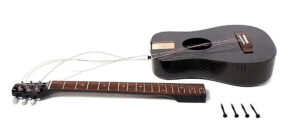
This guitar is a KLOS Black Carbon Fiber Travel Acoustic-Electric Guitar.
You can disconnect the neck in seconds by removing 4 screws.
KLOS Guitars makes the only hybrid carbon fiber acoustic guitar with a premium mahogany neck.
Note: Aside from this example, there are plenty of other good options out there.
Now, a detachable neck is not the only reason why carbon fiber guitars are good for traveling, especially since not all carbon fiber guitars have a detachable neck.
What makes these guitars a great traveling instrument is that most of them are very strong and lightweight instruments.
This makes them ideal for somebody that’s always traveling and really doesn’t want their instrument to break.
Carbon Fiber vs Wood
Finally, the big debate: which is better, carbon fiber guitars or wood guitars?
In order to do this comparison, we’re just going to allow you to listen to both instruments one after the other so that you can fairly judge them based on what matters the most, their sound.
Throughout this entire article, we’ve been talking about what’s different about a carbon fiber guitar that a wood guitar doesn’t have.
In other words, the actual comparison has actually been done since the start of this post!
What’s left for you to do is to actually make a decision without any exterior influence and just determine by yourself which one you genuinely like the most.

Dad, husband, son, and guitarist. I’ve been playing guitar for 20 years. Passion for writing, painting, and photography. I love exploring nature, and spending time with my family. Currently have a Gretsch G5220 Electric Guitar as my main instrument.

